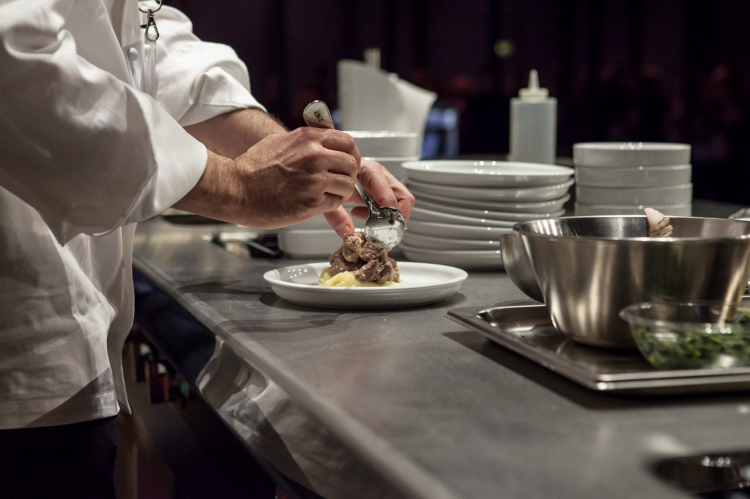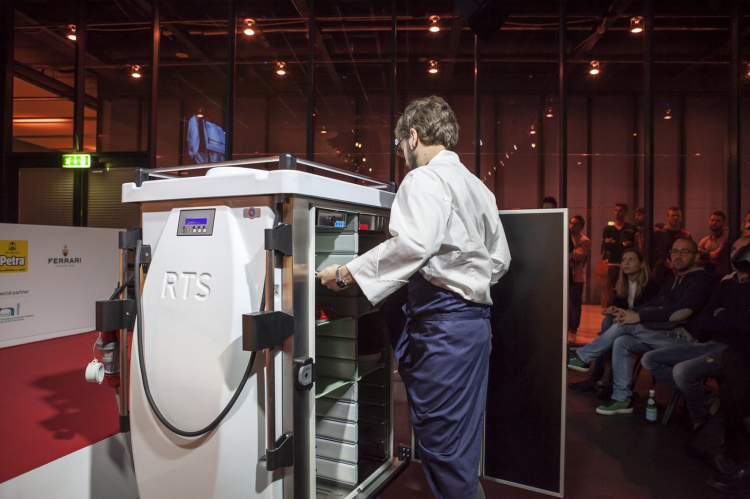Niko Romito arrives at Identità Milano for the 11th time in a row. This time the journey tastes different: «I want to speak to you about a research we’ve been working on for a year and a half. A journey outside the walls of Casadonna. Not a geographic journey but a methodological, social one. It’s about my mission as a chef».
The journey starts from Spazio, «that is to say Rivisondoli, Rome and Milan and could easily extend to New York, London and Tokyo. We want to bring fine dining to a larger and larger portion of consumers, to reach people, widen the offer to an “in between cooking”. Create more links between fine dining and taverns». The journey however lands between two words on which the lesson will focus: «Intelligenza nutrizionale» [Nutritional Intelligence], that is to say a restaurant offer that can be potentially applied on a very large scale: prisons, school canteens, airlines.
The chef from Abruzzo decided to start from hospitals: «I wondered whether it could be possible to cook good and healthy and nice looking food so as to make patients smile». Nutritional intelligence applied to hospitals, however, doesn’t mean just creating simple cookbooks: «We have plenty of those. We’ve defined an experimental research protocol».
The genesis. «Initially, we had to work on three aspects: food cost, the large number of dishes and the non-specialised hospital cooking staff. We needed to imagine a great change». Università Sapienza soon took part in the project: «As chefs, we must confront ourselves more and more with academics and scientists». «We worked for a year and a half in hospital kitchens. We immediately learnt that sanitary rules impose that the supplies are of high quality, but not the resulting food. That is to say, if I destroy the spinach when cooking it, nobody cares. That’s where we had to intervene».
The pilot project involved Cristo Re hospital in Rome. To put it simply, «We applied fine dining techniques to hospital ingredients». And then he lists the 7 techniques, with as many examples.

"The research on techniques for hospital canteens obviously influences the cooking at Reale too” (restaurant with 3 Michelin stars)
1)
Syringing. Excellent for cured meat: «We use syringes for pork with water, balanced salt and aromas, then we dry it in the oven and steam it. The resulting cooked ham tastes good and has no polyphosphates whatsoever».
2)
Vacuum cooking. «One of the problems is that through evaporation, hospital tomatoes usually loose 25/30% of their weight, with huge costs. By cooking in a vacuum at 110°C with balanced aromas and salt, the weight reduction is null and the flavour and texture are unchanged». You can get excellent results even with another great hospital classic, potato purée: «They always make it with powder, milk or water. By vacuum cooking potatoes, bread and water with balanced salts for 40 minutes at 95°C you make a standardised potato purée, but made with real potatoes».
3)
Brine. It gives great results with frozen vegetables. «After numerous experiments we created a mix of water, salt and sugar. When you put the frozen product in brine, cook it in the oven at 230°C for 15 minutes, the result is crispy and brilliant vegetables». Even in this case, the standardised process makes infinite replicas possible.
4) High temperature cooking with a
starch film. For meat and fish: «We can take turkey rump – with balanced salt – brush starch and extra virgin olive oil, cook it at 230°C for 15 minutes. The starch creates an outside film, a sort of barrier that reduces weight loss to 5%, instead of the usual 30%. If you multiply it on a large scale, per year, you’ll save hundreds of thousands of euros».
5)
Steaming. For pulses. «Once you determine the right balance of water, oil, aromas and salt, steaming cooks homogenously. And we can use the cooking water to cook pasta or to make soup».

The prototype of the new service cart, which can regenerate dishes quickly, right before serving them to patients
6)
Cooking pasta. «This was one of the most laborious researches. The problem in a hospital is that pasta is served 40 minutes after cooking it, on average. In order to reduce these criticalities, we worked on 3 elements: speed of penetration in the mixture, starch gelatinization and gluten coagulation. These three factors together can depend from one variable alone, the temperature of the cooking water. If we cook at 80°C, we increase the dehydration time to 35/40 minutes. So as not to allow tomato to tackle starch with its acidity, we gave it the texture of a humid gel: so it covers the pasta without ruining it».
7) The seventh element studies a tool, the
service cart. «We thought this tool should no longer serve just to keep the food warm. It can also regenerate it right before service, at 90 or 120°C». A task that gives more value to people working in catering, who can acquire a new, more important role with higher responsibilities».
From theory to practice:
Romito cooked and summed up costs and nutrients in 3 different hospital menus.
Menu 1: Rice cooked in chards cooked in brine and Veal stew with mashed potatoes (food cost 0.83 euros!).
Menu 2: Pasta with beans, Turkey ham with oil aromatised with citrus fruits, Chicory and chilli pepper (1 euro). Menu 3: Steamed broccoli, Mezze maniche with olives, wild fennel, capers and tomato and Plaice with olives (1.15 euros).
The protocols can have potentially infinite extensions. «The more I move on», the chef said at the end of the lesson, «the more I believe the meaning of what I do is based on large numbers». We have to thank him for sharing such a precise and revolutionary project.
Translated into English by Slawka G. Scarso